Jai (Buddhas Delight) and Chinese New Year Experiment 2011
It seems wrong to start this post with, “Happy New Year!” as I originally intended, rather than, “Happy (belated) Valentine’s Day!” yet here we are two- going on three- weeks after we celebrated Chinese New Year, wishing all of you a Happy New Rabbit Year.
And yes, some of you might be thinking exactly what Bebe Dada voiced. Last night, he bluntly announced that this post is “a little too late, isn’t it?!?” Uhhhhh…. well…. you know how I am these days. I think he made up for this comment, however, when he later said that there was no need to refer to my cooking as “experiments.”
Until I met Bebe Dada, I never celebrated Chinese New Year and I was only familiar with oshogatsu (Japanese New Year’s) customs that I grew up with. However, I have to believe that marrying my Chinese-American husband was nothing less than fate, because it gave a girl who loves food and lives for any special occasion to celebrate with food, yet another reason to enjoy good food with loved ones.
Since Bebe Dada and I started dating, I’ve celebrated Chinese New Year with his family every year in early to mid February. Chinese New Year coincides with the lunar calendar when the new moon appears, therefore the day that the New Year is celebrated differs from year to year. This year, Chinese New Year fell on Thursday, February 3, 2011, but we celebrated with my in-laws a few weekends before to accommodate our various calendars.
We typically feast on a combination of homemade dishes and local restaurant favorites including char-siu (BBQ pork), steamed chicken, yee-mein noodles, Papa’s hoisin ribs, gailan (Chinese broccoli), sweet and sour chicken/pork, Chinese chicken salad (OK this one isn’t traditional but I look forward to this quite a bit as it is my favorite type of salad), gau (steamed rice cake), cupcakes (again, not traditional but delicious) and of course, jai.
The first time I celebrated Chinese New Year with my future in-laws, one of my favorite dishes that my mother-in-law made was what she called “jai”. At the time, I had no idea what it was but I quickly fell in love with the glass noodles, ear wood mushrooms and various ingredients in the jai, including the oysters.
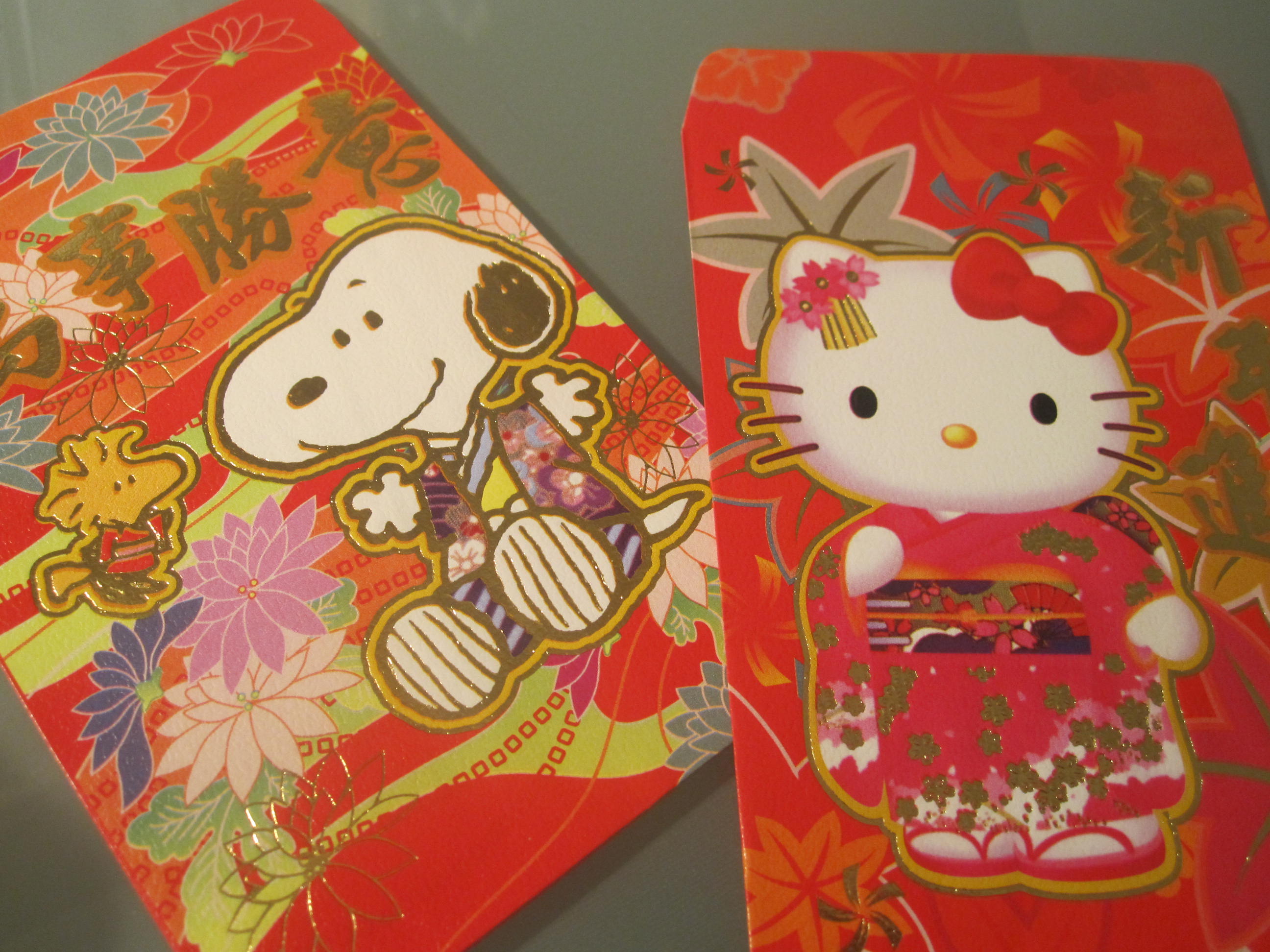 Lai See Envelopes
Lai See Envelopes
According to Wikipedia, red envelopes are presented on Lunar New Year from married elders to the unmarried (or children) and contain gifts of money. This tradition is believed to have originated in the Qin Dynasty where the elderly would thread coins together with red string to ward of evil spirits. Eventually these coins were replaced by printed money and envelopes. A caveat, is to avoid gifting money in fours (40, 400, 44) given the pronunciation of “four” resembles “death”. It is considered bad luck. (The superstition of “four” is the same in Japanese culture and we too avoid gifting anything in fours.) The red color of the envelope symbolizes good luck and is believed to ward off evil spirits.
Jai is also known as Buddha’s delight or lo han jai. According to Wikipedia, traditionally, jai is a vegetarian dish well known in Buddhist and Chinese cuisine and commonly enjoyed by Buddhist monks who follow a vegetarian diet. It is traditionally served in Chinese households on the first day of the Chinese New Year and originates from the old Buddhist practice that one should maintain a vegetarian diet for the first five days of the new year as a form of self-purification.
Last year, on the actual day of Chinese New Year, Bebe Dada and I picked-up Chinese take-out at the last minute from Sam Woo’s to celebrate. I almost forgot it was Chinese New Year but it turned out to be a wonderful excuse for a new Bebe Mama not to cook. This year, however, as Chinese New Year approached, I began to think about which foods we could enjoy on actual New Year’s day, and specifically, what I could cook at home for our family ever year, in addition to our take-out favorites. Basically, I wanted to make our dinner a bit more “traditional” by making a homemade dish.
I immediately thought of my mother-in-law’s jai and decided I would try to recreate this for our family this year. I tend to spend a lot of time focusing on the Japanese customs and foods that I’m more familiar with, but I’d like for Bebe E to grow-up appreciating her Chinese heritage as well. With this in mind, I got a little ambitious and actually made more than one dish over the course of two days, including egg rolls (to be posted… when?!?) and winter melon or tung qwa soup. I also bought two of our favorite dishes from Sam Woo’s, and with our homemade jai we ended up with a relatively nice Chinese New Year dinner.
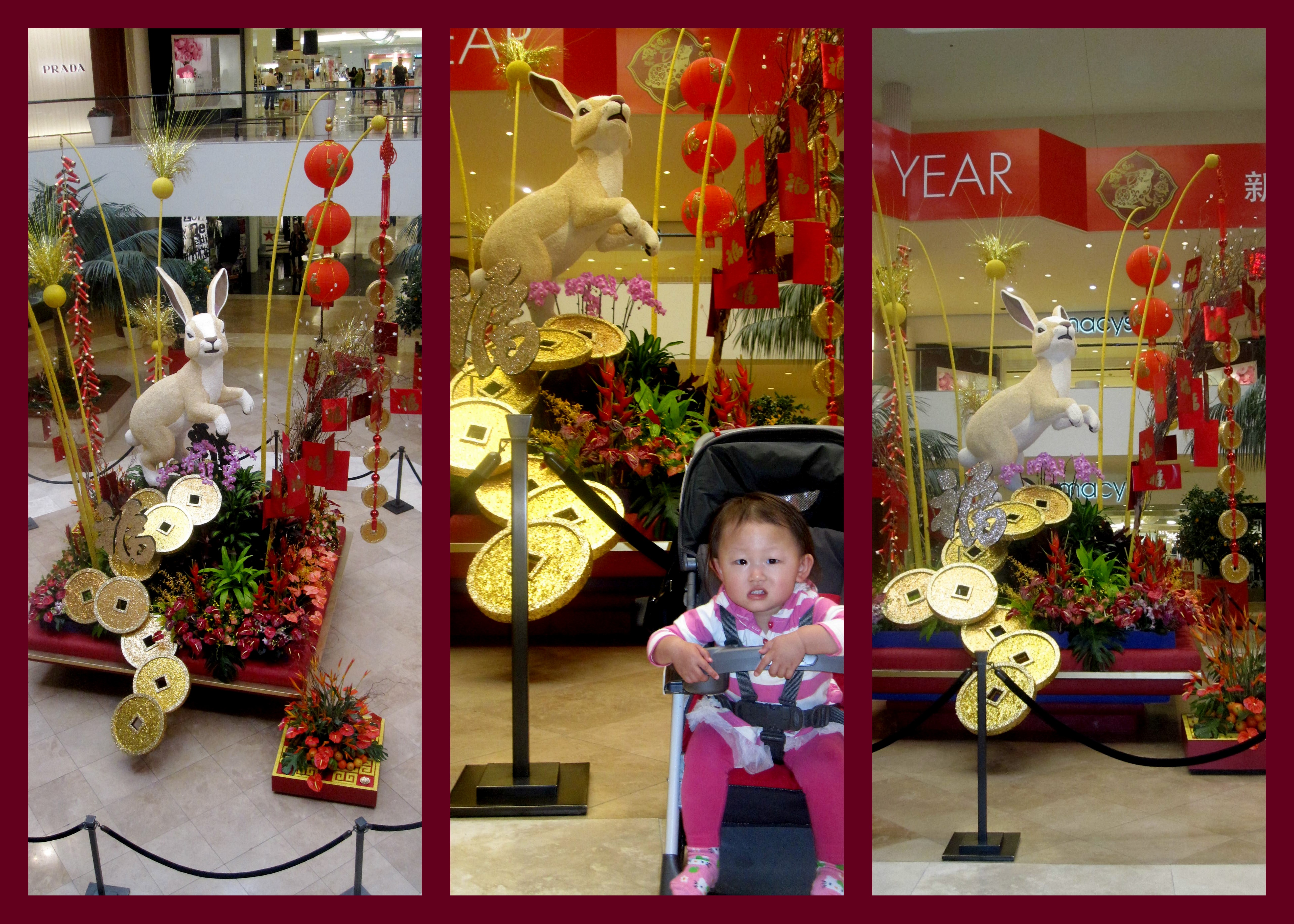 The Chinese New Year Display at South Coast Plaza.
The Chinese New Year Display at South Coast Plaza.
Bebe E is in the middle of saying “cheeeeeese” because I asked her to. Maybe I should try, “smile!” instead. Also, note that Bebe E is shoeless and wearing Hello Kitty socks because her mama realized her shoes weren’t in the backseat of the car as she had originally thought. Oops! Needless to say, Bebe E was slightly miffed that she couldn’t walk around but she’s really just a happy little girl.
Unfortunately, my decision to make jai was poorly timed as I wasn’t able to call Yin-Yin (my mother-in-law and what the girls call their paternal grandma) for advice on how to recreate her dish. Luckily, she managed to reply to my email while on her trip overseas and helped me to name some key ingredients and taught me how to season the jai.
She suggested the following: 1) fermented red bean curd to help flavor the jai; 2) continuously add water as the jai cooks down; 3) you can’t go wrong adding oyster sauce; 4) soak all of your dried goods overnight; 5) as a short cut, use a can of lo-han-jai to season the jai.
Despite Yin-Yin’s email and advice, I still needed help. I had no idea how to cook this dish and I had problems with #2 – finding this ingredient at the market as well as how to incorporate the tartness of the fermented red bean curd, and #5 – locating a can of lo-han-jai.
I found an article on jai in the Honolulu Star Bulletin, and since Yin-Yin is from Hawaii, I thought this would be a good guide and perhaps give me further insight into recreating Yin-Yin’s jai. What I especially liked about this article, however, was the ingredient wheel with detailed Chinese and English translations of each item.
You’d think that with the knowledge I gained from the ingredient wheel I’d have an easier time shopping at the Chinese supermarket but Bebe E and I spent over an hour looking for ingredients. My attempts to ask for help only resulted in additional walking back and forth in the market, carefully looking up and down the same aisles more than two or three times, but we finally came home with a good handful of ingredients, albeit a few substitutions with items which I deemed “close enough” to what I thought we were looking for.
Jai Experiment #1
(Chinese name of ingredient is italicized in parenthesis. Red text is the symbolization of each ingredient.)
- About 5 ounces dried mung bean noodles (fun see); also called long rice, sai fun or glass noodles – long life
- 5 to 6 dried shiitake mushrooms (dong gu); also called black mushrooms – welcome Spring & seize opportunities
- 5 to 6 dried black ear wood mushrooms (ha mok yi) ;also called tree ear mushrooms or black fungus – long life
- Dried black moss (fat choy), about a 2 x 2 inch square piece – wealth
- 1/4 cup dried lily flower bulbs; Yin-Yin uses golden lily buds (gum jum) but I couldn’t find these – wealth
- 1 package fresh bean curd strips; Yin-Yin uses dried bean curd sticks (foo jook) – blessings
- 4 pieces fried tofu (chow doufu), cut into slices (packaged in the refrigerated section) – blessings
- 1 small package fresh gingko nuts (bak ko), rinsed (peeled and boiled, found in refrigerated section) – silver ingots (coins) & good fortune
- 1 small can water chestnuts (ma tal); Yin-Yin uses fresh water chestnuts – unity
- 1 small carrot, thinly sliced – good luck, gold coins and wealth
- 1 cup snow peas, stringy veins removed – unity
- 1/2 cup bamboo shoots, cut into matchsticks; substituted for bamboo piths (jook tseng) – long life
- 1 cup chicken broth (use vegetable broth for vegetarian option)
- 1/2 cup water
- 1 to 2 tablespoons canola or vegetable oil (Yin-Yin uses peanut oil but Bebe E is allergic)
- 1 to 2 teaspoons sesame oil
- 4 to 6 tablespoons oyster sauce (to taste)
- Dash of salt and pepper to taste, if necessary
- Raw peanuts (far sung), optional – birth
- Dried oysters (ho see), optional; Yin-Yin typically adds these but I omitted them – good luck & good things
1) As a short-cut, soak dried shiitake (black) mushrooms and ear wood mushrooms in hot water for 30 minutes. We have a Zojirushi self-boiling Air Pot (water dispenser) that we’ve used in the past for some of our bebe needs but it is super handy in the kitchen for rehydrating dried ingredients, among other things.
Once soft, slice shiitake mushrooms into lengthwise pieces and chop ear wood mushrooms into bite-sized pieces or strips. I just rough chopped these out of laziness.
 Ear Wood mushrooms (Tree Ear Black Fungus);
Ear Wood mushrooms (Tree Ear Black Fungus);
Bottom Right: Shiitake (Black) Mushrooms
2) In separate bowls, also soak dried black moss and mung bean noodles.
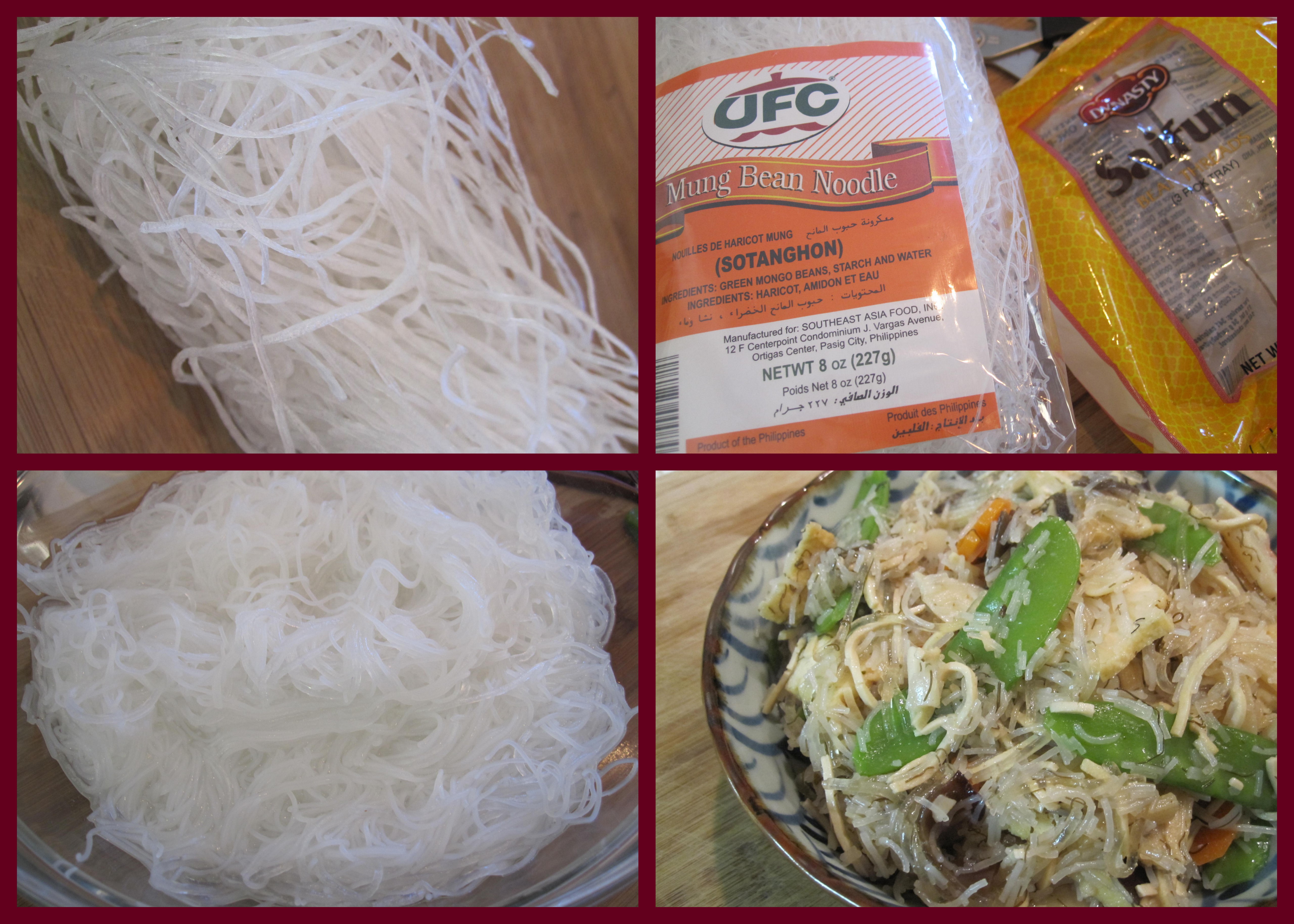 Mung Bean (Saifun or Glass) Noodles
Mung Bean (Saifun or Glass) Noodles
3) I started to soak the dried lily flower bulbs but after carefully reading the instructions on the back of the package, instead I boiled these for about 2o minutes. Honestly, they didn’t become as tender as I thought they would be and at one point I wasn’t even sure if I had the right type of dried lily flower because I didn’t quite recognize this as one of the ingredients in Yin-Yin’s jai.
4) Although I found the bean curd strips in the refrigerated section, I didn’t know what to do with them. I’m not sure what compelled me to do this, but I rinsed them with hot water. This probably wasn’t a good idea. The strips, or noodles, broke-up into smaller pieces.
After Yin-Yin returned, I found out that I’m supposed to buy the dried bean curd threads because these have more flavor. Again, oh well. It’s an experiment, right? Perhaps I’ll try to find the dried ones next time. The good news about using fresh bean curd strips is that these were extremely easy to use as I didn’t need to soak them.
5) I also soaked the raw peanuts according to the instructions in the Honolulu Bulletin jai article, but I ended up omitting these completely. I planned to make one version with peanuts and a second peanut-free version for Bebe E but I’m realizing now that it’s easier to simply omit all peanuts from our kitchen.
6) In a measuring cup with a spout, mix 1 cup chicken broth and dilute with 1/2 cup water. Set aside.
7) Clean snow peas by pinching off the tip on one end with your fingernails and strip stringy vein off. Repeat with the other end and pull string along the opposite side so that both sides of the snow pea is stripped of the stringy vein that is often so difficult to chew. Blanch the snow peas for 3 minutes. Quickly drain and shock with ice water to maintain their vibrant green color.
8) Slice carrots. I tried to make a little decorative groove in the carrot, but we all know I’m just a mom in the kitchen with no cooking training so I ended up with funny looking carrot slices, but they still tasted great. Blanch the carrots in boiling water for 4 minutes, until just tender, then drain and shock with ice water.
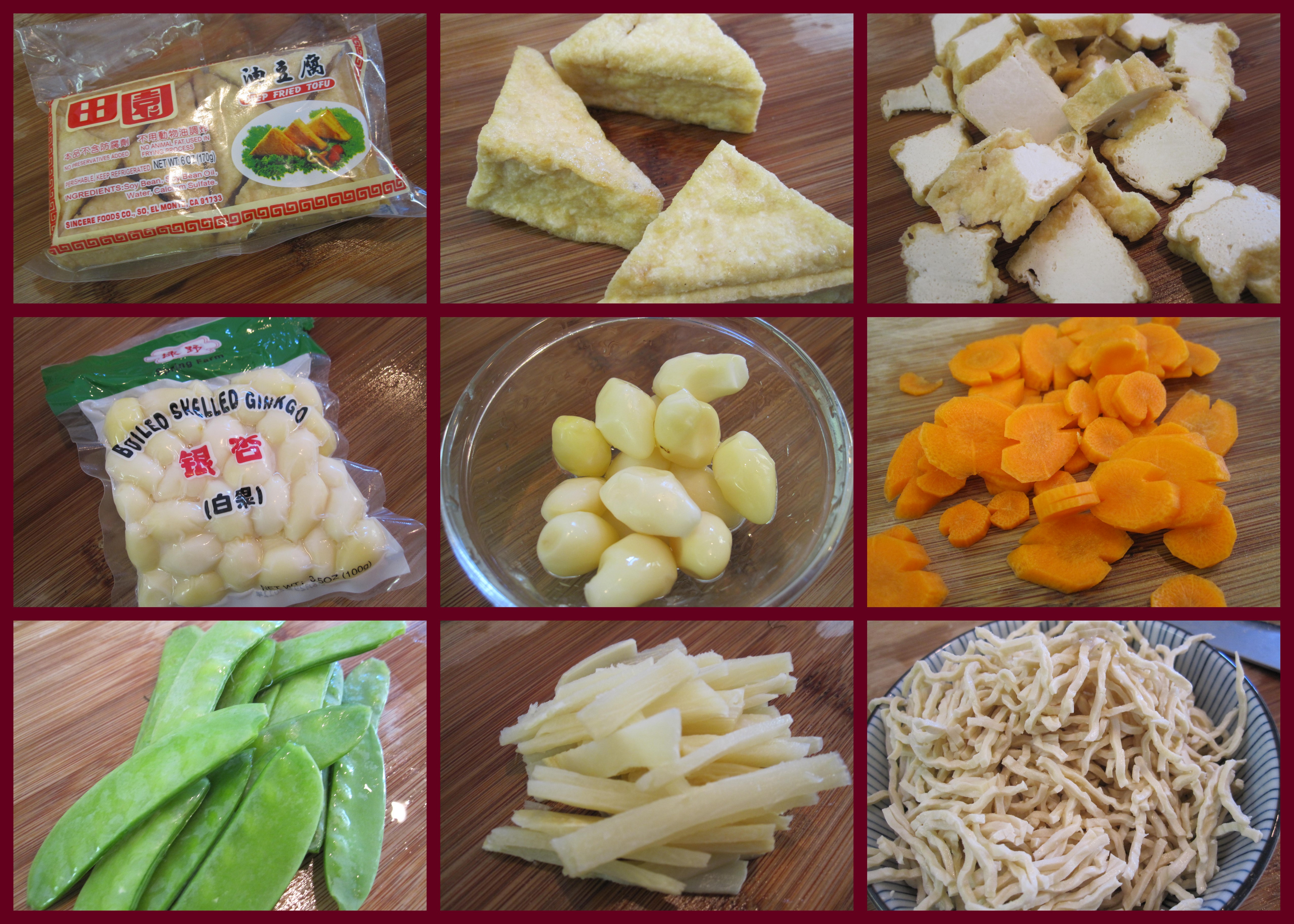 Top Row: Fried Tofu;
Top Row: Fried Tofu;
Center: Gingko Nuts and Bean Curd Strips;
Bottom: Snow Peas, Bamboo Shoots, Carrots
9) In a large pot (or wok, if you have one), heat a little vegetable oil and sesame oil over medium-high heat then add and gently stir-fry: shiitake mushrooms, ear wood mushroom, fresh bean curd threads, gingko nuts and lily bud flower petals. (Add peanuts at this point if using.) At this point I added a little bit of the chicken (vegetable) broth mixture.
Next add fried tofu, black moss, bamboo shoots and water chestnuts. The black moss tends to clump so I did my best to separate the strands. For some reason, I really like the black moss although you really can’t taste it. Gently toss, then add a bit more broth and 1 tablespoon oyster sauce.
 The stringy black moss, fried tofu and the ear wood mushrooms are my favorites.
The stringy black moss, fried tofu and the ear wood mushrooms are my favorites.
Next, drain mung bean noodles. These should be soft and pliable. Add to the pot and gently stir. Add a bit more of the broth, 2 – 3 tablespoons oyster sauce, stir and allow this to cook for about 15 minutes. Continue to add the broth as the liquid evaporates and is absorbed into the noodles. Taste the jai, and add additional 1 tablespoon of oyster sauce if necessary. Yin-Yin’s jai tends to have a delicate flavor so I tended towards seasoning my jai experiment on the lighter side.
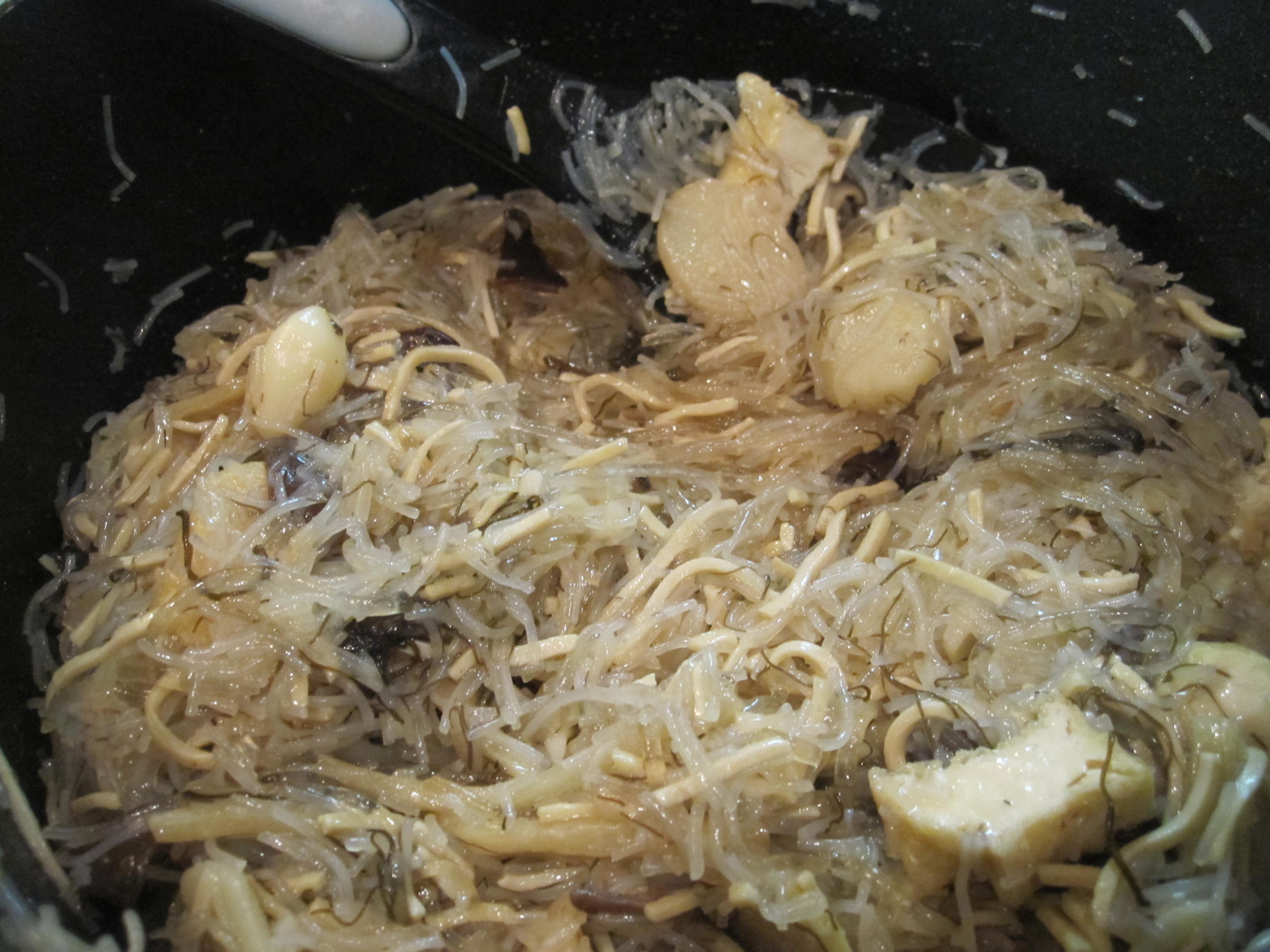 The mung bean noodles begin to break as I cooked the jai although I did my best to preserve the long glass noodles.
The mung bean noodles begin to break as I cooked the jai although I did my best to preserve the long glass noodles.
After the noodles were cooked, I added the snow peas and carrots, allowing them to warm-up for a minute or two, then turned off the heat.
My first experiment with jai was quite satisfying. Bebe Dada said, “it tastes just like Yin-Yin’s” but he was saying this to be nice. :) I think Yin-Yin’s jai tastes far superior, but my experimental jai did indeed taste quite good.
With the leftover mung bean noodles, I will soon make a simpler version of my experimental jai with noodles, bean curd threads, fried tofu, mushrooms, black moss and vegetables. I like the fact that this dish is meatless and I love this dish so much that I couldn’t possibly wait until next year to make this again!
Again, Happy New Year! or Gung Hay Fat Choy! Our family’s unofficial, official Chinese dialect is Cantonese since this is what Yin-Yin speaks, but Big Onechan taught me that it is Xin Nian Kuai Le in Mandarin. Either way, may 2011 be a fabulous year!
bebe mama
* * * * * * * *
Year of the Rabbit
Born: 1915, 1927, 1939, 1951, 1963, 1975, 1987, 1999, 2011
Characteristics: Gracious, good friend, kind, sensitive, soft-spoken, amiable, elegant, reserved, cautious, artistic, thorough, tender, self-assured, shy, astute, compassionate, lucky, and flexible. Can be moody, detached, superficial, self-indulgent, opportunistic, and stubborn.
Motto: “I relax!”
Color: Grey
Compatible with: Sheep, Boars
Avoid: Rooster signs
Good Careers: Lawyer, Diplomat, Actor
- About 5 ounces dried mung bean noodles (fun see); also called long rice, sai fun or glass noodles -long life
- 5 to 6 dried shiitake mushrooms (dong gu); also called black mushrooms -
- welcome Spring & seize opportunities
- 5 to 6 dried black ear wood mushrooms (ha mok yi);also called tree ear mushrooms or black fungus -long life
- Dried black moss (fat choy), about a 2 x 2 inch square piece -wealth
- ¼ cup dried lily flower bulbs; Yin-Yin uses golden lily buds (gum jum) but I couldn't find these -wealth
- 1 package fresh bean curd strips; Yin-Yin uses dried bean curd sticks (foo jook) -blessings
- 4 pieces fried tofu (chow doufu), cut into slices (packaged in the refrigerated section) -blessings
- 1 small package fresh gingko nuts (bak ko), rinsed (peeled and boiled, found in refrigerated section) - silver ingots (coins) & good fortune
- 1 small can water chestnuts (ma tal); Yin-Yin uses fresh water chestnuts -
- unity
- 1 small carrot, thinly sliced - good luck, gold coins and wealth
- 1 cup snow peas, stringy veins removed -unity
- ½ cup bamboo shoots, cut into matchsticks; substituted for bamboo piths (jook tseng) -long life
- 1 cup chicken broth (use vegetable broth for vegetarian option)
- ½ cup water
- 1 to 2 tablespoons canola or vegetable oil (Yin-Yin uses peanut oil)
- 1 to 2 teaspoons sesame oil
- 4 to 6 tablespoons oyster sauce (to taste)
- Dash of salt and pepper to taste, if necessary
- Raw peanuts (far sung), optional - birth
- Dried oysters (ho see), optional - good luck & good things
- As a short-cut, soak dried shiitake (black) mushrooms and ear wood mushrooms in hot water for 30 minutes.
- Once soft, slice shiitake mushrooms into lengthwise pieces and chop ear wood mushrooms into bite-sized pieces or strips. I just rough chopped these out of laziness.
- In separate bowls, also soak dried black moss and mung bean noodles.
- Boil dried lily flower bulbs about 20 minutes until tender.
- If you are using dried bean curd strips, instead of fresh, soak these in water overnight.
- If using peanuts, soak these overnight.
- In a measuring cup with a spout, mix 1 cup chicken broth and dilute with ½ cup water. Set aside.
- Clean snow peas by pinching off the tip on one end with your fingernails and strip stringy vein off. Repeat with the other end and pull string along the opposite side so that both sides of the snow pea is stripped of the stringy vein that is often so difficult to chew.
- Blanch the snow peas for 3 minutes. Quickly drain and shock with ice water to maintain their vibrant green color.
- Slice carrots. Then blanch the carrots in boiling water for 4 minutes, until just tender, then drain and shock with ice water.
- In a large pot (or wok, if you have one), heat a little vegetable oil and sesame oil over medium-high heat then add and gently stir-fry: shiitake mushrooms, ear wood mushroom, fresh bean curd threads, gingko nuts and lily bud flower petals. (Add peanuts at this point if using.) At this point I added a little bit of the chicken (vegetable) broth mixture.
- Next add fried tofu, black moss, bamboo shoots and water chestnuts. The black moss tends to clump so I did my best to separate the strands. For some reason, I really like the black moss although you really can't taste it. Gently toss, then add a bit more broth and 1 tablespoon oyster sauce.
- The stringy black moss, fried tofu and the ear wood mushrooms are my favorites.
- Next, drain mung bean noodles. These should be soft and pliable. Add to the pot and gently stir. Add a bit more of the broth, 2 - 3 tablespoons oyster sauce, stir and allow this to cook for about 15 minutes. Continue to add the broth as the liquid evaporates and is absorbed into the noodles. Taste the jai, and add additional 1 tablespoon of oyster sauce if necessary. Yin-Yin's jai tends to have a delicate flavor so I tended towards seasoning my jai experiment on the lighter side.
- The mung bean noodles begin to break as I cooked the jai although I did my best to preserve the long glass noodles.
- After the noodles were cooked, add the snow peas and carrots, allowing them to warm-up for a minute or two, then turned off the heat.



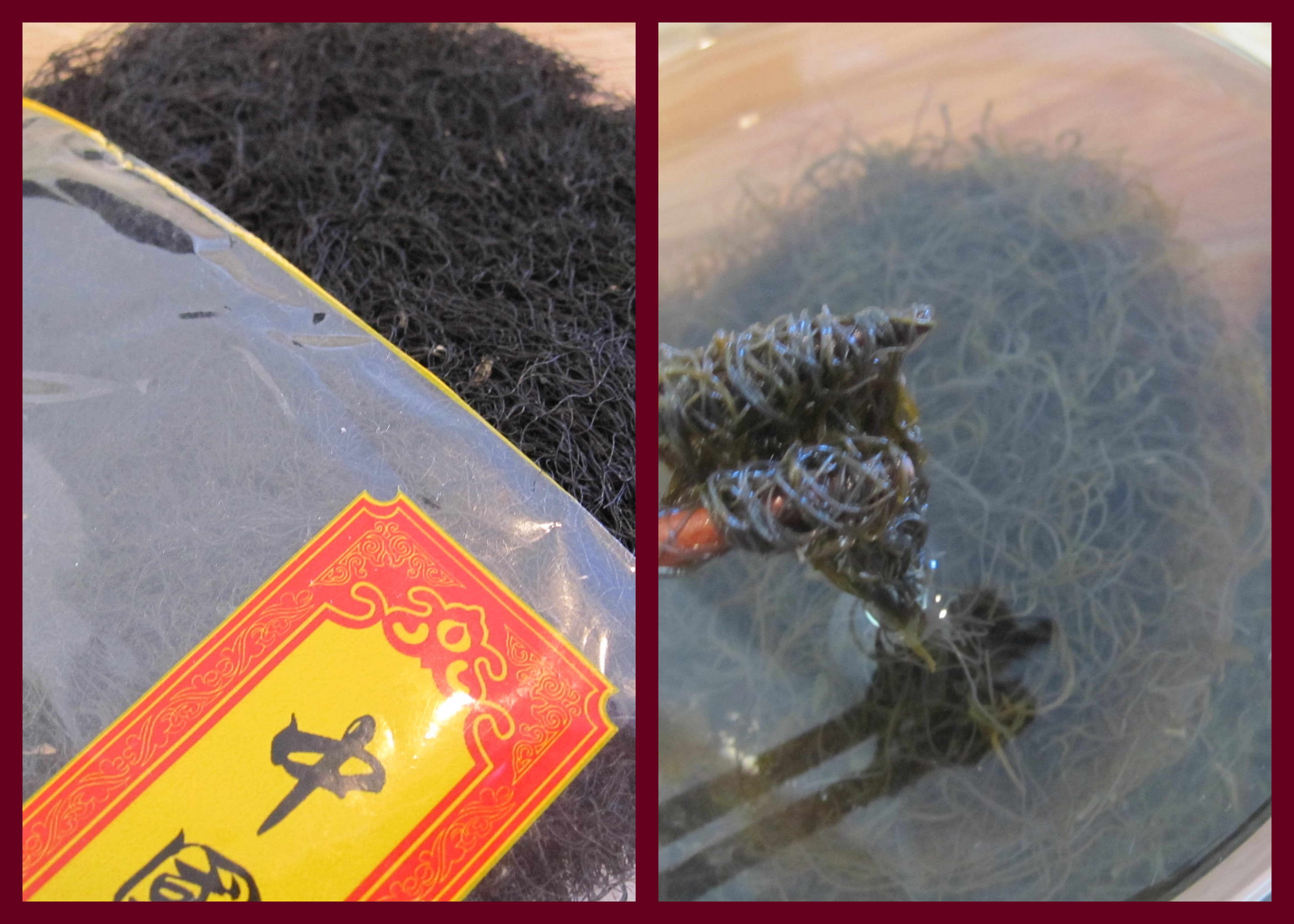
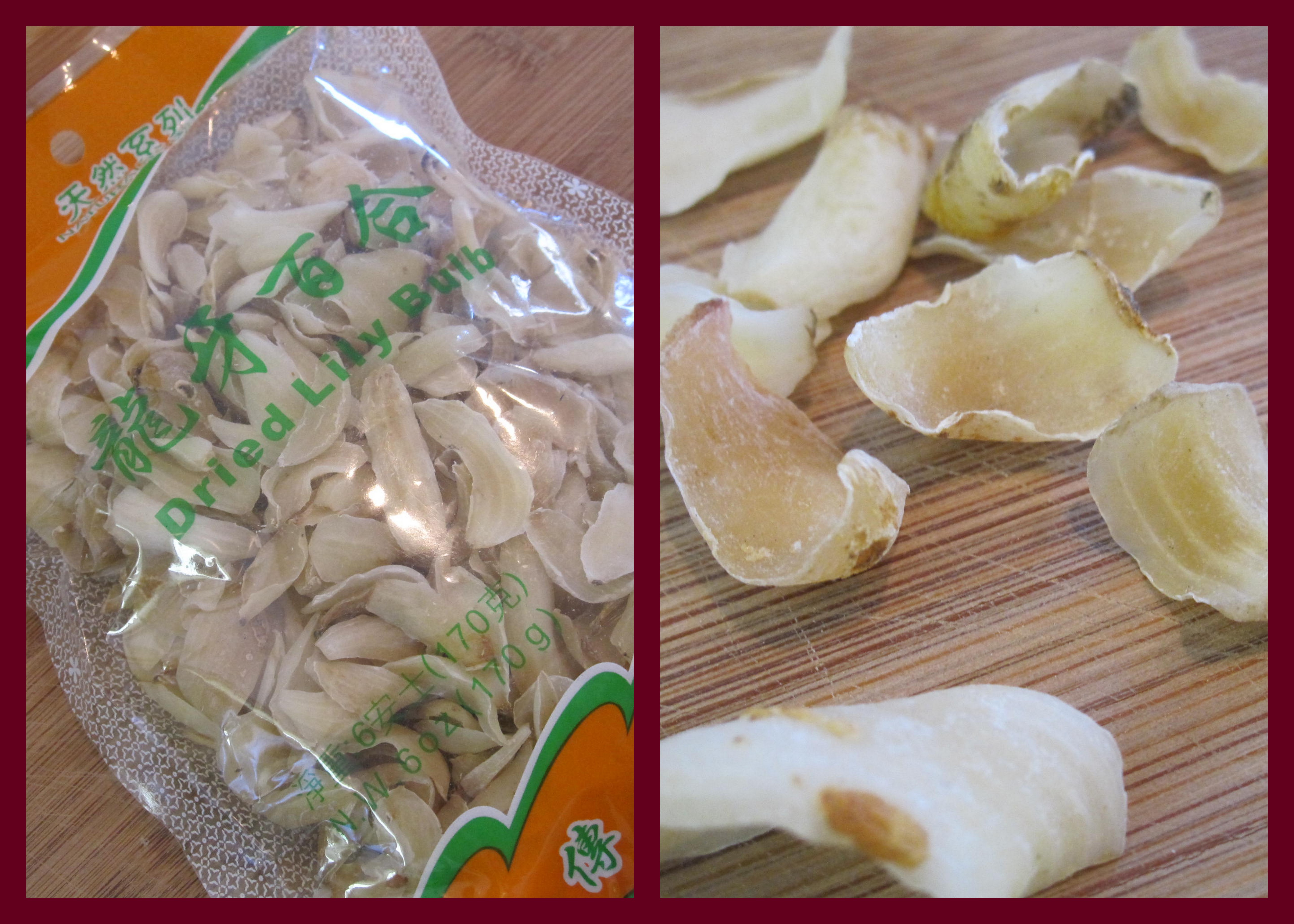
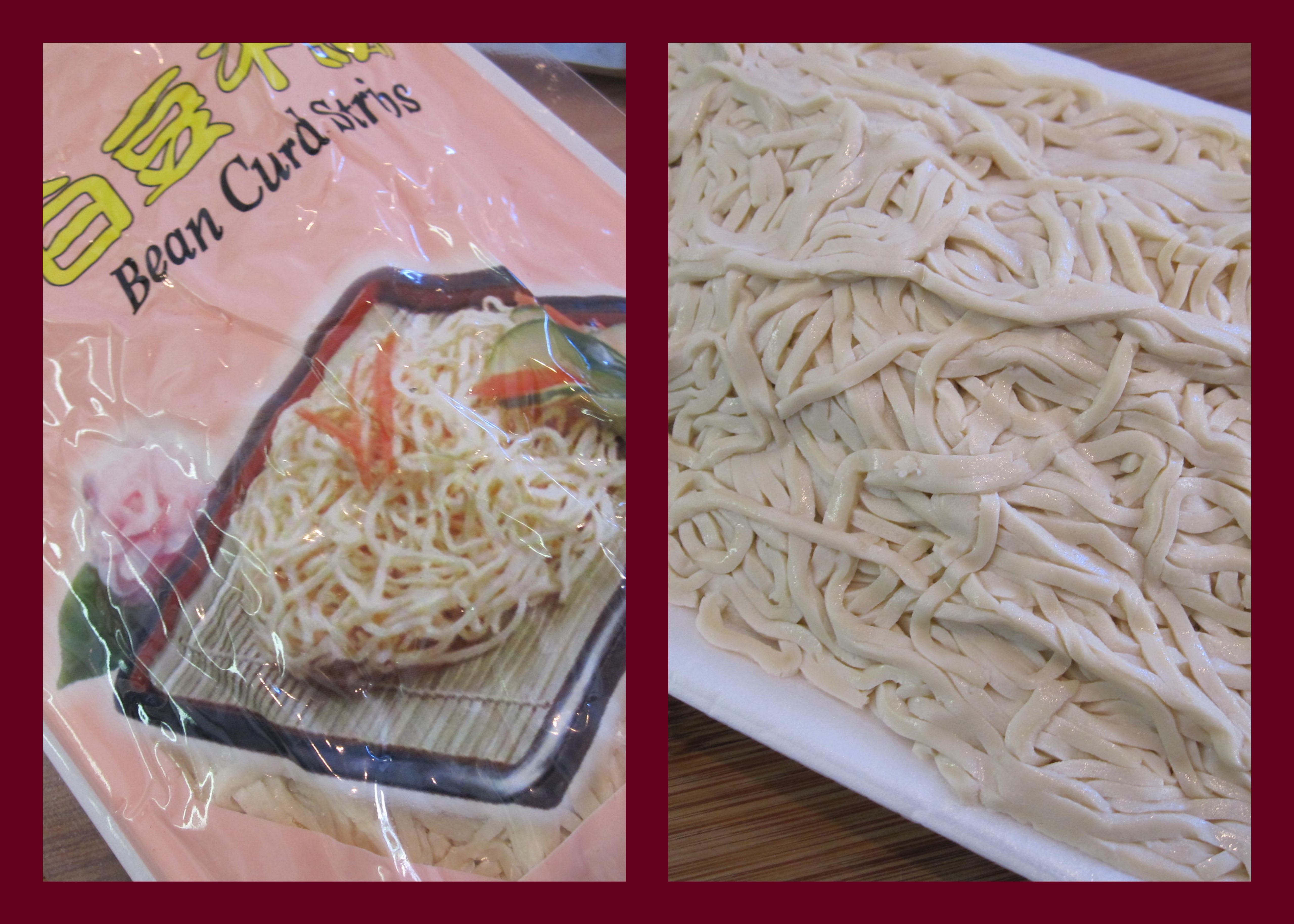
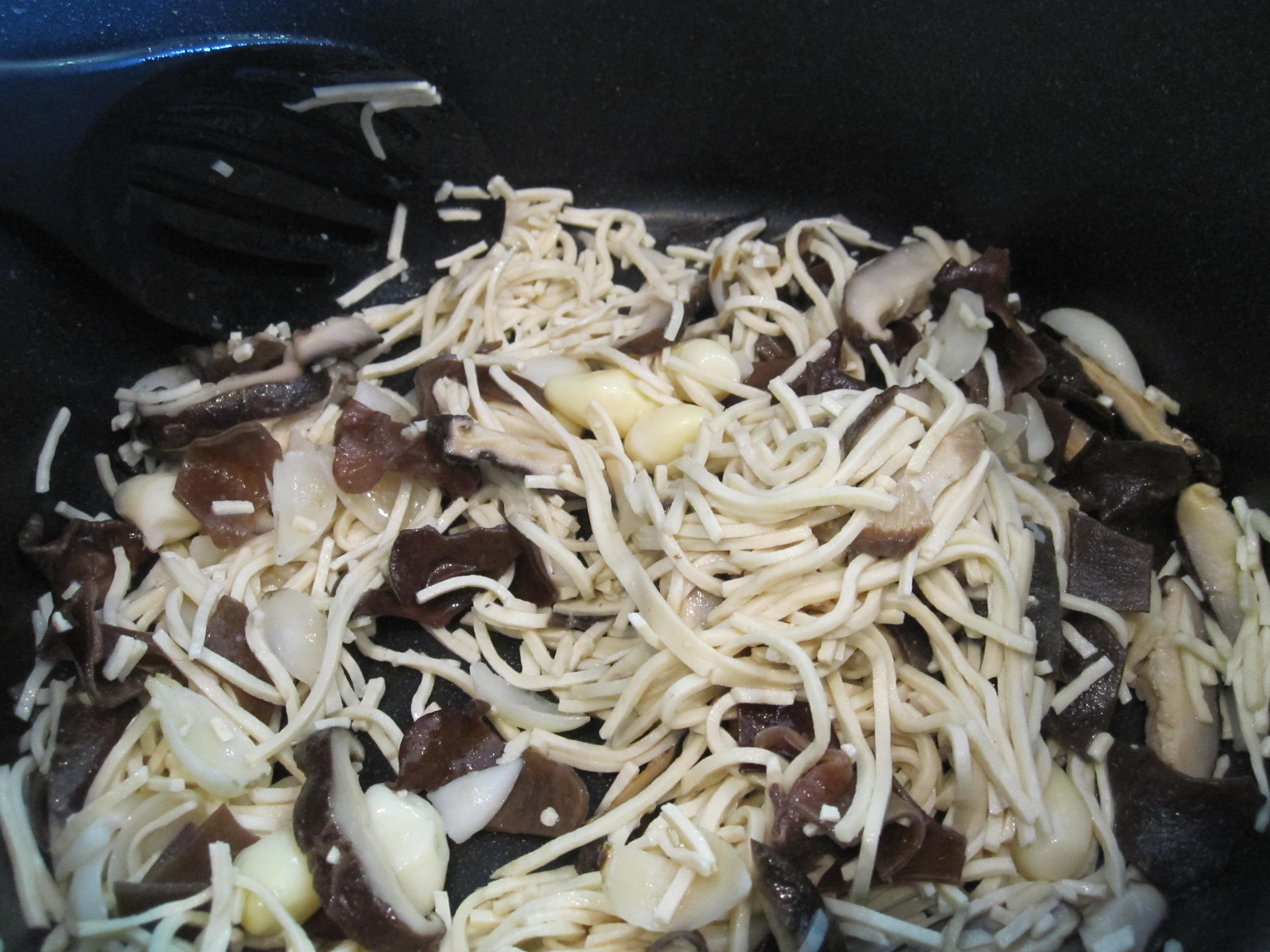

12 Comments